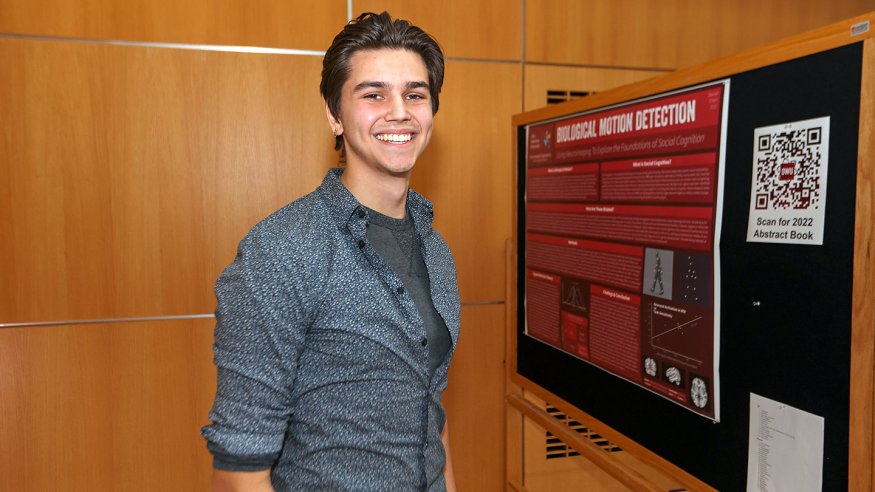
‘Biological Motion Detection’
Ohio Wesleyan Senior Conducts Neuroimaging Research at Nationwide Children’s Hospital
Name: Daniel Eilert ’23
Hometown: Loveland, Ohio
Major: Philosophy
Minors: Physics and Music
OWU Connection Experience: Research internship
Eilert completed a summer internship studying “Biological Motion Detection: Using Neuroimaging to Explore the Foundations of Social Cognition” at Nationwide Children’s Hospital in Columbus, Ohio. He is continuing to analyze the results this semester under the mentorship of OWU’s Kira Bailey, Ph.D., associate professor of Psychology and Neuroscience.
“I’ve had an interest in neuroscience for quite some time,” Eilert said. “After dabbling in both physics and philosophy at OWU, there's something about studying the brain that feels like a natural synthesis of these interests to me.”
At Nationwide Children’s
“I was given a desk and computer with all the software I needed to communicate with the supercomputing cluster used by the hospital for their more computationally intensive neuroimaging data analysis. I was in the Biobehavioral Health Department working in the Nelson Lab under principal investigator Eric E. Nelson, Ph.D. The lab focuses on brain maturation throughout adolescence and uses a variety of neuroimaging techniques to study the development of different social cognitive processes.”
‘Interpreting Neuroimaging Data’
“I relied heavily on the generous help of both my PI and a few research assistants to help guide my training and began the internship by doing lots of background reading on both the physics of neuroimaging as well as the theory behind the task we determined I’d be working with.
“I ended up using pilot data for an ongoing study at the lab, ‘Social Outcomes in Preterm Adolescents,’ which meant that my dataset was quite small (N=9). While this ultimately limited the scope of statistically significant findings I could hope to obtain in the end, there was still plenty to be learned from walking through the process of interpreting neuroimaging data from start to finish.”
Identifying Brain Trends
“I learned the pipeline of processing raw data files from the MRI machine so that, after many careful steps, I could use a program called AFNI (Analysis of Functional NeuroImages) to run useful statistical tests on all the voxels (think 3D pixels) in the thousands of brain images that were collected and compare the BOLD (Blood Oxygenation Level Dependent) responses of the different subjects while performing our task to identify trends across all their brains.
“I selected an area of the brain that showed increased activity during specific experimental conditions and then compared the average activity in this region to each subject’s overall performance on the task and found a pretty good correlation between these two things (R^2=0.73).
“Going forward with a bigger pool of data, this study will move in a number of directions to tackle even larger questions by relating performance on this specific task to other measures from related tasks and behavioral assessments of broader social cognitive scope.”
My Favorite Moment
“I did a lot of coding over the summer which came with quite a learning curve so, hands down, some of my most ecstatic moments during the internship were when I just got some code to run that I’d been troubleshooting for days. It’s really an exhilarating feeling.
“Looking at the bigger picture, I did some reading on previous studies that used similar tasks to ours and began to get a sense of the different regions of the brain that are involved in the functional network responsible for the detection of biological motion. These papers almost always include a table of coordinates for the location of important regions of the brain that are being referenced. I began to record the coordinates identified in some of these papers and so then it was super exciting when I ran the relevant tests on our data and obtained coordinates pointing to roughly the same spot in our brain model.”
Lessons Learned
“My experience covered a lot of ground and there were tons of ways it tied back to my learning experiences at OWU. One class I could not stop thinking about during my research at Nationwide was the ‘Philosophy of Science’ course I just took with Dr. (Erin) Flynn last semester. A lot of the theoretical and somewhat abstract ideas we discussed in that class were pinned down to more tangible and experiential examples for me as I got to see how some real scientists are actually conducting their experiments in a flourishing field.
“As far as bringing skills from the internship to my future plans, even if a career in neuroscience isn’t the path I ultimately choose, a lot of the skills I acquired, especially those needed for data processing, are skills that can easily be applied to almost any other field.
“Toward the end of my internship, I got the opportunity to script a few machine learning models in python that made predictions about the responses of subjects based on their brain activity data. While even my best model was only able to achieve about 60% accuracy, machine learning is obviously a hot tool right now in many fields and only continues to improve. Learning how to fit different types of models to my dataset was really helpful in understanding the underlying principles behind even larger scale applications of artificial intelligence.”
Why I Chose Ohio Wesleyan
“I chose OWU for two main reasons. First, I wasn’t sure exactly what I wanted to do and OWU was somewhere that was going to allow me to double major in pre-engineering and vocal performance. Second, given the scholarship I was offered, it just made financial sense for my situation.”
My Plans After Graduation
“My plan after graduation is to find a job and live happily ever after. OK sure, the specifics are still unclear, but despite this, I still do feel strongly that the liberal arts experience I’ve had at OWU bouncing around from physics to music and from fine arts to philosophy has given me a well-rounded educational foundation that prepares me for a wide range of possible post-grad paths.”
